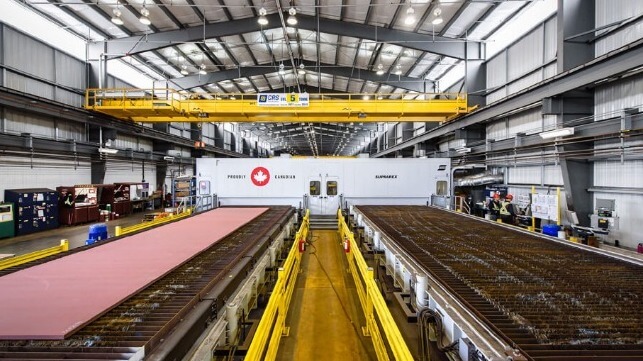Seaspan Starts “Prototype Block” for Canada's First Polar Icebreaker

Canada’s Seaspan Shipyards reported that work began this week as the next step in preparing for full scale construction of the Canada’s first new heavy polar icebreaker in more than 60 years. The shipyard located near Vancouver in British Columbia cut the first pieces of steel in a test block they will be assembling to confirm the unique construction processes and train staff before work begins to build the vessel in 2024.
With Canada’s current largest Icebreaker, the CCGS Louis S. St-Laurent, set to retire at the end of the decade after 60 years of service, the new polar icebreaker has become the cornerstone of the Canadian government’s National Shipbuilding Strategy. Construction on the vessel however is far behind the original timeline with critics also saying that its costs will skyrocket before it is finally delivered. Canada first announced plans for the new vessel in 2018. The following year, Vard was retained to design work and then in September 2020, Seaspan Shipyards and Genoa Design announced that they had entered into an exclusive teaming agreement to design and build the future polar Icebreakers. The government has already announced plans for a second vessel before work had begun on the first ship.
Before full rate construction on the polar icebreaker begins, Seaspan is developing a prototype block to test the new systems, processes, people, and tools that are required to work with some of the very thick, specialized steel that is required to manufacture a heavy polar icebreaker. According to the shipyard, some of this steel will be up to 60-millimeters thick, to enable the ship to safely navigate through the multi-year ice that is found in the Arctic.
“Cutting steel on the prototype block is a key milestone for the Polar Icebreaker Program and demonstrates Seaspan’s capabilities across engineering, design, supply chain, planning and production,” said Martin Edwards, Chief Program Officer at Seaspan Shipyards. He noted that the lessons learned from building the block will be used to help improve the quality and efficiency of the process for designing and manufacturing the vessel when production begins in late 2024.
Seaspan reports it has already gained significant experience designing and building polar Ccass vessels including three Offshore Fisheries Science Vessels which are now in service with the Canadian Coast Guard as well as an Offshore Oceanographic Science Vessel that is currently under construction at its Vancouver Shipyards location and a class of sixteen Multi-Purpose Vessels (also Polar Class) that is currently in design.
They are highlighting that the Polar Icebreaker will be an incredibly complex ship, designed to operate in the Arctic’s ice-covered waters, and will play a critical role in enabling the Canadian Coast Guard to transit and protect the Arctic coastline. With a displacement of 27,876 tonnes, the icebreaker will be 518 feet in length. It will be able to operate farther north, in more difficult ice conditions, and for longer periods than any of Canada’s current or previous icebreakers.
